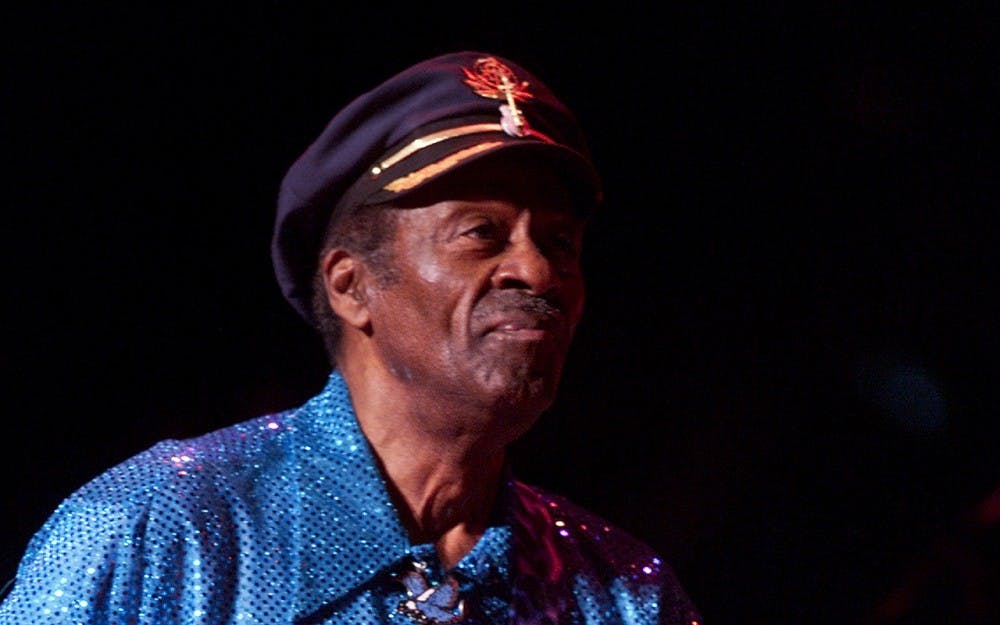Rock ‘n’ roll pioneer Chuck Berry can tell Tchaikovsky the news himself as of last Saturday, when the rock legend died at the age of 90.
Before the Beach Boys, before the Beatles and before Elvis, there was Charles Edward Anderson Berry and his combination of rhythm, blues and country that was rock ‘n’ roll in the 1950s.
“He’s the Beethoven of rock ‘n’ roll,” senior lecturer in music Andrew Hollinden said.
Berry was the first artist to establish the electric guitar as a lead instrument.His music mixed jazz and blues techniques, with influence from the guitar of T-Bone Walker and songwriting and lyricism of Louis Jordan. His first big hit, “Maybellene,” spent nine weeks at number one on Billboard’s rhythm-and-blues chart. His other hits include “Roll Over Beethoven” and “Johnny B. Goode,” which was even sent to space aboard the Voyager’s golden record intended for alien life.
“That’s the ultimate rock song,” provost professor of music Glenn Gass said. “It has the perfect lead and rhythm guitars, the perfect lyrics telling that story about Johnny B. Goode. There’s so many perfect rock songs, but to me, that’s the ultimate example.”
Berry’s success was due to his flamboyant performances — the duck walk being his trademark crowd pleaser — combined with his lyrical content, Gass said.
“To the Beatles, Chuck Berry was like this great pop-rock poet,” Gass said. “He wrote more syllables per second than anybody.”
Despite being a black artist in the 1950s, Berry was well received by white audiences that enjoyed country music and black audiences that enjoyed rhythm and blues.
“Chuck Berry realized ‘I can write songs right at my audience,’ so he started writing songs about rock ‘n’ roll,” Hollinden said.
His music resonated particularly with young audiences, Gass said.
“He wrote little mini-movies about teenage life in America,” Gass said.
Commercial success came frequently for Berry, with “Maybellene” reaching No. 1 on the Billboard rhythm-and-blues chart, “School Day” topping at No. 3 on the pop chart and “Sweet Little Sixteen” reaching No. 2.
His success motivated him to found a club in St. Louis called the Club Bandstand with the intention of making a safe space for all attendees, regardless of race. Billboard’s No. 1 ranking of “Johnny B. Goode” on the rhythm-and-blue chart indicated how white and black America appreciated his lyrics and musical style.
“White America became hip to electric rhythm and blues and then ran with it,” Hollinden said. “It made him palatable to America in the broadest sense.”
At the height of his popularity in 1959, though, Berry was arrested and accused of having sex with a 14-year-old girl, who he transported across state lines. He was eventually convicted and served a year and a half in a prison in Terre Haute, Indiana. After he got out, he saw some more commercial success, but his career never reached the height it had before his arrest.
“As a result of his incarceration, he was more of a loner,” Hollinden said. “He was understandably bitter and less trusting.”
Music tastes changed. The Beatles and Beach Boys were taking rock and pop elsewhere. While still a popular performer and recording act, Berry did not adapt to the changes in music happening around him and stuck to the genre as he knew it. Berry started touring by himself and performing with local bands that knew his songs.
Even though he never reached the same level of popularity, he continued to play rock ‘n’ roll as he knew it.
“He defined the alphabet, the musical language of rock ‘n’ roll,” Gass said. “He was defiantly himself no matter what ... He could have tried to write different music and sound more contemporary, but he knew who he was.”






